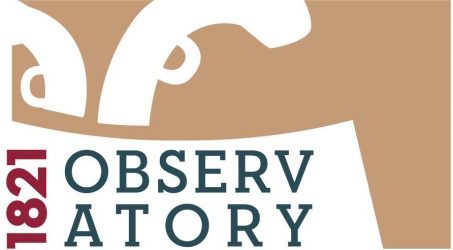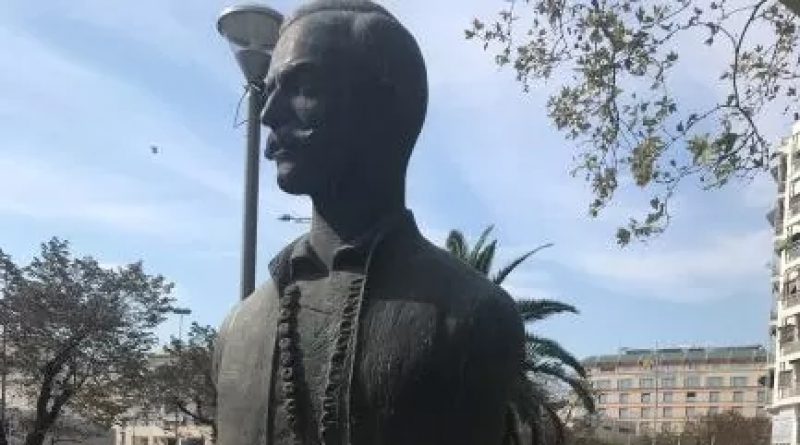Georgakis Olympios, the Thessalonian fighter
The militant Georgakis Olympios was a Thessalian klepht/armatole and one of the most heroic figures of the 1821 Revolution in the Danubian Principalities. He was born in 1772 in the village of Livadi in Olympus and came from the famous Lazas family of armatoles in Olympus and the wider Pieria region.[1]
When the Serbian Uprising broke out in 1804, Olympios, along with other armatoles from Macedonia, Epirus and Thessaly, supported the revolt of the Serbian armatole Veljko Petrović against the Ottoman army. After the failure of the uprising, Olympios remained in Serbia, from where he communicated with the Greek ruler of Wallachia, Konstantinos Ypsilantis, for the creation of a combat-worthy military corps in the Danubian Principalities, in which Greek revolutionaries and fighters from the principalities would participate. This corps, when the Russo-Turkish War was declared in 1806, fought under Russian commander-in-chief Kutuzov and achieved important victories.[2] Olympios fought heroically at the battle of Vidin, in Wallachia. For his heroic deeds on the battlefield, Tsar Alexander I awarded him the Order of Saint Anne.[3]
In 1817, Olympios was initiated into the Philiki Etairia by Georgios Leventis. In the summer of 1820, Alexandros Ypsilantis appointed him commander-in-chief of the revolutionary forces in the Danubian Principalities. In January 1821, on Ypsilantis’ orders, Olympios and other revolutionaries in Bucharest, incited the local chieftain, Tudor Vladimirescu, to revolt. When, on 23 February 1821, Ypsilantis crossed the Pruth River and proclaimed the revolution in the Danubian Principalities, Olympios was his right-hand man, his loyal comrade. However, Ypsilantis’ movement was suppressed by the Ottoman forces, after the serious losses incurred at the battle of Dragashani, Wallachia, on 7 June 1821.[4]
After the defeat at Dragashani, Olympios and about 300 fighters were pursued by the troops of Salih Pasha and found refuge in August 1821 in Secu Monastery. The battles against the Ottoman forces continued in the valleys surrounding the monastery. However, unable to face the numerical superiority of the Ottomans, the rebels barricaded themselves inside the monastery on 5 September and resisted starvation and captivity for 13 days. But when the Ottomans managed to enter the monastery, Olympios led the few survivors to the bell tower, where he blew up a barrel of gunpowder, killing both the rebels and the invaders.[5]
After the heroic death of Olympias, his widow and their three children moved in 1842, from Russia where they lived, to Greece, to secure from the Greek government the pension of the dead hero and to live with dignity. The family, however, lived in a state of absolute destitution and poverty, as according to the legislation they were recognised as heterochthonous (Greeks born outside of the state) and were excluded from the pension granted to the widows and orphans of the heroes who sacrificed themselves in the name of the revolution.[6]
Olympias’ revolutionary ethos and heroic self-sacrifice were a source of inspiration for European philhellene intellectuals. For example, in 1822, the poem of the philhellene pastor, teacher and writer Ludwig Karl Stuckert, “Georgakis Olympios: A branch of tears at the grave of the fallen Greeks”, was published in Basel, Switzerland. The Historical and Ethnological Society of Greece, in the context of the bicentenary the Greek Revolution, honouring the selfless contribution of Olympios in the struggle to shake off the Ottoman yoke in the Balkan countries, proceeded to republish the above poem in 2022, in a translation by Dimitrios Tselepis.[7]
In the same spirit, the Holy Metropolis of Fthiotida honoured the life and revolutionary action of Olympios in the Danubian Principalities, at a special anniversary event entitled “Holocausts of Sacrifice on the Altar of Freedom”, which took place online, on 27 July 2021.[8]
Vasiliki Filiou, PhD candidate in modern and contemporary history at the Department of History and Ethnology, Democritus University of Thrace
[1] For more on the life and activities of Olympios, see Theodoros Fragou, Γεωργάκης Ολύμπιος 1772-1821 [Georgakis Olympios, 1772-1821] (Athens: Georgakis Olympios Association of Livadiots, 1964).
[2] “Γεωργάκης Ολύμπιος” [Georgakis Olympios], Wikipedia (Greek), https://el.wikipedia.org/wiki/%CE%93%CE%B5%CF%89%CF%81%CE%B3%CE%AC%CE%BA%CE%B7%CF%82_%CE%9F%CE%BB%CF%8D%CE%BC%CF%80%CE%B9%CE%BF%CF%82
[3] Vasilis Zarzonis, “Το άδοξο τέλος της οικογένειας του Γεωργάκη Ολύμπιου” [The ignominious end of the family of Georgakis Olympios], En Olympos 17 (2021): 12, https://enolympo.gr/images/flip/no17/index.html.
[4] Thomas Liolios, “Ο αγωνιστής την ελευθερία ή την κερδίζει μαχόμενος ή την καθαγιάζει πεθαίνοντας” [4/3/1772–4/3/2021: 249 words for the 249 years since the birth of the national hero Georgakis Olympios], En Olympos 17 (2021): 11, https://enolympo.gr/images/flip/no17/index.html.
[5] Nikos Gaintatzis, “Τα γεγονότα του 1821 στη Βόρεια Μολδαβία: Γεωργάκης Ολύμπιος και Ιωάννης Φαρμάκης” [The events of 1821 in northern Moldavia: Georgakis Olympios and Ioannis Farmakis], Makedonika 13 (1973), 227–66. It is reported that the surviving rebels numbered 12.
[6] Zarzonis, “Το άδοξο τέλος.”
[7] Ludwig Karl Stuckert, Γεωργάκης Ολύμπιος: Ένα κλωνάρι δακρύων στον τάφο των πε-σόντων Ελλήνων [Georgakis Olympios: A branch of tears at the grave of the fallen Greeks], trans. Dimitris Tselepis (Athens: Historical and Ethnological Society of Greece, 2022), https://nhmuseum-shop.gr/ekdoseis/meletes/georgakis-olympios-suiss-detail.
[8] Specifically, in the context of the online anniversary event organized by the Holy Diocese of Fthiotida on 27 July 2021, the life and revolutionary action of Georgakis Olympios were developed in a talk by Apostolis Samiotis, a student of the Philosophy School of the Aristotle University of Thessaloniki, https://youtu.be/7yoi5IjogyA.

